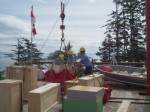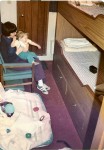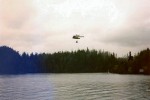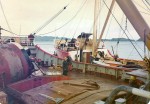Moving Day 1970s

One of the problems with moving to another lighthouse was that everything had to be crated and or well-packed to withstand the dangers of the transportation and handling by ship and/or helicopter. It also had to survive unexpected falls and/or water damage, both fresh and salt.
When my wife Karen and I first moved on the lighthouses we had no material for crating so we had to get professionals from a moving company to do the work for us. They did a very good job but were very expensive.
When we got the bill we did not have the money to pay for it, so we told the man we would leave half the furnishings there in the warehouse and get them shipped out next month when we got paid. He was having nothing of that and eventually dropped the price to something we could afford.
I will give them credit – some of those cedar-framed crates are probably still circulating on the lights after thirty years of use. I know I used some of them to move off McInnes when I left. We loaned out a lot of them too for other keepers to use.
Most of the transportation was by Coast Guard ships which meant moving the furnishings from the house to a tractor and trailer (if available) and then over hundreds of feet of rough boardwalk to the highline platform where it was unloaded and the tractor and driver were off again for another load. This heavy manual labour was performed by the two keepers and numerous personnel off the ships. It was hard and thirsty work and involved buying many cases of beer from the ship’s canteen to keep all happy.
Once unloaded from the tractor onto the ground, the items were selected according to size and/or weight to fit into a bonnet sling. These were large round tarpaulins with loops around the sides, or square open nets through which snotters1 were fitted. (see first photo)

The winch operator then dragged the slings across the deck so they were centred under the highline carriage. Many slings were being loaded at a time so they could not all be directly under the carriage. Also, many was the time when we were unloading and loading at the same time – either another keeper’s belongings or groceries and or supplies. Loads would come up from the workboat and land on the deck until the workboat was empty. The bonnets were unloaded and the materials were stacked, stored or moved, and the next bonnet in line was attached and sent back to the boat.

This continued until the workboat was again full and returned to the main Coast Guard supply ship. The supply ship then hoisted the cartons, crates and other materials from the workboat and over the gunwale and dropped them into the forward hold where they were then unloaded from the slings and stored on shelves in the hold.
Earlier, in the 1950s – there were no coolers or freezers on the ships so all merchandise went into the hold. In later years (1970s), the cartons containing perishables were stored in the appropriate storage area such as freezer or cooler.
Once all had been moved and good-byes said, we all climbed into the again empty workboat along with all the crew and headed off to our new lightstation. This could be one day or one week away. The

crew made us welcome and we ate with the officers. This meant that they had to make room for, in our case, three, or four new people for eating and sleeping. Also pets travelled with us as well. Most of the animals were kept in the forward chain locker area although we were sometimes allowed to bring the cats to our cabins. In the case of dogs they were usually well-looked after by the ship’s crew who would take them out tidbits of food from the galley.
On arriving at the new station the whole procedure was repeated in reverse – all six steps.
Another alternative to this scenario was to move the cartons and

crates and furnishings to the helicopter pad where they would be slung out to the ship in the same type of net bonnet sling, or loaded on the helicopter for transport to a Coast Guard base or even to the appointed lighthouse if it was relatively close by. The helicopter was also used to carry some of the more unpackable or fragile items such as lamps, aquariums, mirrors, etc.
This all depended on good weather and the ship arriving on time. Living out of crates was done a few times and many a time we moved in the rain. I must say, that the only thing I ever remember getting broken was a parchment lampshade that I had packed wrongly.

There were many variations on this standard move. One time at Pachena Point because of bad weather for the ship, the furnishings were slung in bonnet nets and slings under the helicopter to Bamfield where the Coast Guard ship from Victoria, the CCGS Sir James Douglas, waited out of the wind. There they were landed on the quayside and man-handled onto the ship. At this time I had two plastic twenty litre carboys of beer brewing which got moved to Green Island without incident. Left to settle for a week, it was ready for bottling.

Actually that move was a very different one. After going through all of the above, we met the supply ship from Prince Rupert , the CCGS Alexander Mackenzie, in Shushartie Bay , a nice sheltered spot on the east coast of northern Vancouver Island. There the two ships tied up side by side and our supplies were transferred from one to the other while at anchor. When finished we sailed north to Prince Rupert and eventually Green island, and the Victoria ship proceeded on her re-supply trip down the inside waters. Again, all arrived safely.
FOOTNOTE:
1snotter – a length of rope or braided steel with a loop braided or fixed in either end.
– John Coldwell (BC Lighthouse Keeper 1969 – 2001
Just read this article. It takes me back. I had brand new furniture delivered to Egg Island. All went well ’till the box with my new headboard came ashore. The winch swung and the headboard landed with a big hole in the top. Those winches were tricky.